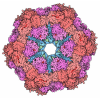[English] 日本語
 Yorodumi
Yorodumi- PDB-7f5b: LBD-TMD focused reconstruction of DNQX-bound GluK2-1xNeto2 complex -
+ Open data
Open data
- Basic information
Basic information
| Entry | Database: PDB / ID: 7f5b | ||||||
|---|---|---|---|---|---|---|---|
| Title | LBD-TMD focused reconstruction of DNQX-bound GluK2-1xNeto2 complex | ||||||
 Components Components |
| ||||||
 Keywords Keywords | MEMBRANE PROTEIN / Ionotropic glutamate receptors / Single-pass transmembrane proteins | ||||||
| Function / homology |  Function and homology information Function and homology informationmossy fiber rosette / detection of cold stimulus involved in thermoception / Activation of Na-permeable kainate receptors / kainate selective glutamate receptor complex / Activation of Ca-permeable Kainate Receptor / negative regulation of synaptic transmission, glutamatergic / regulation of short-term neuronal synaptic plasticity / inhibitory postsynaptic potential / glutamate receptor activity / ubiquitin conjugating enzyme binding ...mossy fiber rosette / detection of cold stimulus involved in thermoception / Activation of Na-permeable kainate receptors / kainate selective glutamate receptor complex / Activation of Ca-permeable Kainate Receptor / negative regulation of synaptic transmission, glutamatergic / regulation of short-term neuronal synaptic plasticity / inhibitory postsynaptic potential / glutamate receptor activity / ubiquitin conjugating enzyme binding / neurotransmitter receptor localization to postsynaptic specialization membrane / regulation of neurotransmitter receptor localization to postsynaptic specialization membrane / receptor clustering / modulation of excitatory postsynaptic potential / regulation of JNK cascade / kainate selective glutamate receptor activity / ionotropic glutamate receptor complex / extracellularly glutamate-gated ion channel activity / neuronal action potential / behavioral fear response / positive regulation of synaptic transmission / glutamate-gated receptor activity / ligand-gated monoatomic ion channel activity involved in regulation of presynaptic membrane potential / presynaptic modulation of chemical synaptic transmission / excitatory postsynaptic potential / dendrite cytoplasm / hippocampal mossy fiber to CA3 synapse / SNARE binding / synaptic transmission, glutamatergic / transmitter-gated monoatomic ion channel activity involved in regulation of postsynaptic membrane potential / PDZ domain binding / regulation of membrane potential / postsynaptic density membrane / regulation of long-term neuronal synaptic plasticity / ionotropic glutamate receptor binding / modulation of chemical synaptic transmission / terminal bouton / intracellular calcium ion homeostasis / positive regulation of neuron apoptotic process / presynaptic membrane / scaffold protein binding / chemical synaptic transmission / postsynaptic membrane / perikaryon / neuron apoptotic process / negative regulation of neuron apoptotic process / postsynaptic density / axon / neuronal cell body / glutamatergic synapse / synapse / ubiquitin protein ligase binding / dendrite / membrane / identical protein binding / plasma membrane Similarity search - Function | ||||||
| Biological species |  | ||||||
| Method | ELECTRON MICROSCOPY / single particle reconstruction / cryo EM / Resolution: 3.9 Å | ||||||
 Authors Authors | He, L.L. / Gao, Y.W. / Li, B. / Zhao, Y. | ||||||
| Funding support |  China, 1items China, 1items
| ||||||
 Citation Citation |  Journal: Nature / Year: 2021 Journal: Nature / Year: 2021Title: Kainate receptor modulation by NETO2. Authors: Lingli He / Jiahui Sun / Yiwei Gao / Bin Li / Yuhang Wang / Yanli Dong / Weidong An / Hang Li / Bei Yang / Yuhan Ge / Xuejun Cai Zhang / Yun Stone Shi / Yan Zhao /  Abstract: Glutamate-gated kainate receptors are ubiquitous in the central nervous system of vertebrates, mediate synaptic transmission at the postsynapse and modulate transmitter release at the presynapse. In ...Glutamate-gated kainate receptors are ubiquitous in the central nervous system of vertebrates, mediate synaptic transmission at the postsynapse and modulate transmitter release at the presynapse. In the brain, the trafficking, gating kinetics and pharmacology of kainate receptors are tightly regulated by neuropilin and tolloid-like (NETO) proteins. Here we report cryo-electron microscopy structures of homotetrameric GluK2 in complex with NETO2 at inhibited and desensitized states, illustrating variable stoichiometry of GluK2-NETO2 complexes, with one or two NETO2 subunits associating with GluK2. We find that NETO2 accesses only two broad faces of kainate receptors, intermolecularly crosslinking the lower lobe of ATD, the upper lobe of LBD and the lower lobe of LBD, illustrating how NETO2 regulates receptor-gating kinetics. The transmembrane helix of NETO2 is positioned proximal to the selectivity filter and competes with the amphiphilic H1 helix after M4 for interaction with an intracellular cap domain formed by the M1-M2 linkers of the receptor, revealing how rectification is regulated by NETO2. | ||||||
| History |
|
- Structure visualization
Structure visualization
| Movie |
 Movie viewer Movie viewer |
|---|---|
| Structure viewer | Molecule:  Molmil Molmil Jmol/JSmol Jmol/JSmol |
- Downloads & links
Downloads & links
- Download
Download
| PDBx/mmCIF format |  7f5b.cif.gz 7f5b.cif.gz | 374.4 KB | Display |  PDBx/mmCIF format PDBx/mmCIF format |
|---|---|---|---|---|
| PDB format |  pdb7f5b.ent.gz pdb7f5b.ent.gz | 295.7 KB | Display |  PDB format PDB format |
| PDBx/mmJSON format |  7f5b.json.gz 7f5b.json.gz | Tree view |  PDBx/mmJSON format PDBx/mmJSON format | |
| Others |  Other downloads Other downloads |
-Validation report
| Summary document |  7f5b_validation.pdf.gz 7f5b_validation.pdf.gz | 1 MB | Display |  wwPDB validaton report wwPDB validaton report |
|---|---|---|---|---|
| Full document |  7f5b_full_validation.pdf.gz 7f5b_full_validation.pdf.gz | 1.1 MB | Display | |
| Data in XML |  7f5b_validation.xml.gz 7f5b_validation.xml.gz | 63.8 KB | Display | |
| Data in CIF |  7f5b_validation.cif.gz 7f5b_validation.cif.gz | 93.3 KB | Display | |
| Arichive directory |  https://data.pdbj.org/pub/pdb/validation_reports/f5/7f5b https://data.pdbj.org/pub/pdb/validation_reports/f5/7f5b ftp://data.pdbj.org/pub/pdb/validation_reports/f5/7f5b ftp://data.pdbj.org/pub/pdb/validation_reports/f5/7f5b | HTTPS FTP |
-Related structure data
| Related structure data |  31464MC  7f56C  7f57C  7f59C  7f5aC M: map data used to model this data C: citing same article ( |
|---|---|
| Similar structure data |
- Links
Links
- Assembly
Assembly
| Deposited unit | 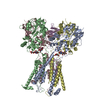
|
|---|---|
| 1 |
|
- Components
Components
-Protein , 2 types, 5 molecules ABCDE
| #1: Protein | Mass: 102475.961 Da / Num. of mol.: 4 / Mutation: F107L Source method: isolated from a genetically manipulated source Source: (gene. exp.)   Homo sapiens (human) / References: UniProt: P42260 Homo sapiens (human) / References: UniProt: P42260#2: Protein | | Mass: 59413.652 Da / Num. of mol.: 1 Source method: isolated from a genetically manipulated source Source: (gene. exp.)   Homo sapiens (human) / References: UniProt: C6K2K4 Homo sapiens (human) / References: UniProt: C6K2K4 |
|---|
-Sugars , 2 types, 8 molecules 
| #3: Polysaccharide | Source method: isolated from a genetically manipulated source #4: Sugar | ChemComp-NAG / |
|---|
-Non-polymers , 2 types, 2 molecules 
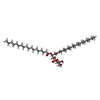

| #5: Chemical | ChemComp-CA / |
|---|---|
| #6: Chemical | ChemComp-PGT / ( |
-Details
| Has ligand of interest | Y |
|---|
-Experimental details
-Experiment
| Experiment | Method: ELECTRON MICROSCOPY |
|---|---|
| EM experiment | Aggregation state: PARTICLE / 3D reconstruction method: single particle reconstruction |
- Sample preparation
Sample preparation
| Component | Name: LBD-TMD focused reconstruction of DNQX-bound GluK2-1xNeto2 complex Type: COMPLEX / Entity ID: #1-#2 / Source: RECOMBINANT |
|---|---|
| Source (natural) | Organism:  |
| Source (recombinant) | Organism:  Homo sapiens (human) Homo sapiens (human) |
| Buffer solution | pH: 7.4 |
| Specimen | Embedding applied: NO / Shadowing applied: NO / Staining applied: NO / Vitrification applied: YES |
| Vitrification | Cryogen name: ETHANE |
- Electron microscopy imaging
Electron microscopy imaging
| Experimental equipment |  Model: Titan Krios / Image courtesy: FEI Company |
|---|---|
| Microscopy | Model: FEI TITAN KRIOS |
| Electron gun | Electron source:  FIELD EMISSION GUN / Accelerating voltage: 300 kV / Illumination mode: FLOOD BEAM FIELD EMISSION GUN / Accelerating voltage: 300 kV / Illumination mode: FLOOD BEAM |
| Electron lens | Mode: BRIGHT FIELD |
| Image recording | Electron dose: 60 e/Å2 / Detector mode: SUPER-RESOLUTION / Film or detector model: GATAN K2 SUMMIT (4k x 4k) |
- Processing
Processing
| Software | Name: PHENIX / Version: 1.18.2_3874: / Classification: refinement | ||||||||||||||||||||||||
|---|---|---|---|---|---|---|---|---|---|---|---|---|---|---|---|---|---|---|---|---|---|---|---|---|---|
| CTF correction | Type: NONE | ||||||||||||||||||||||||
| 3D reconstruction | Resolution: 3.9 Å / Resolution method: FSC 0.143 CUT-OFF / Num. of particles: 148300 / Symmetry type: POINT | ||||||||||||||||||||||||
| Refine LS restraints |
|
 Movie
Movie Controller
Controller








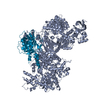

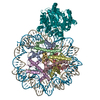
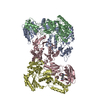

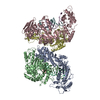
 PDBj
PDBj
